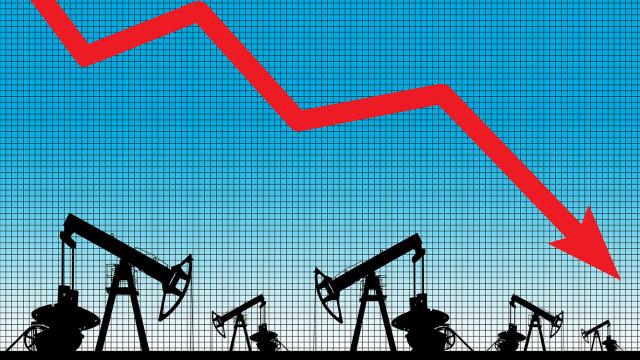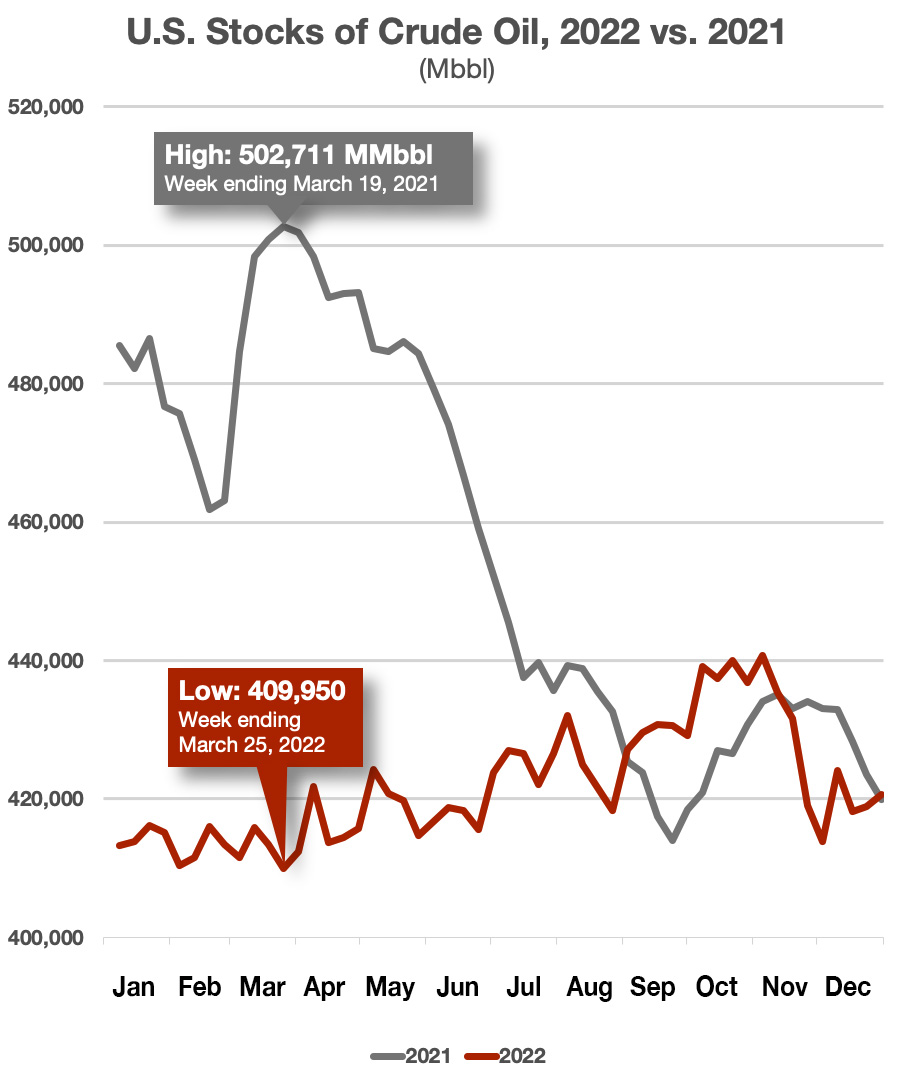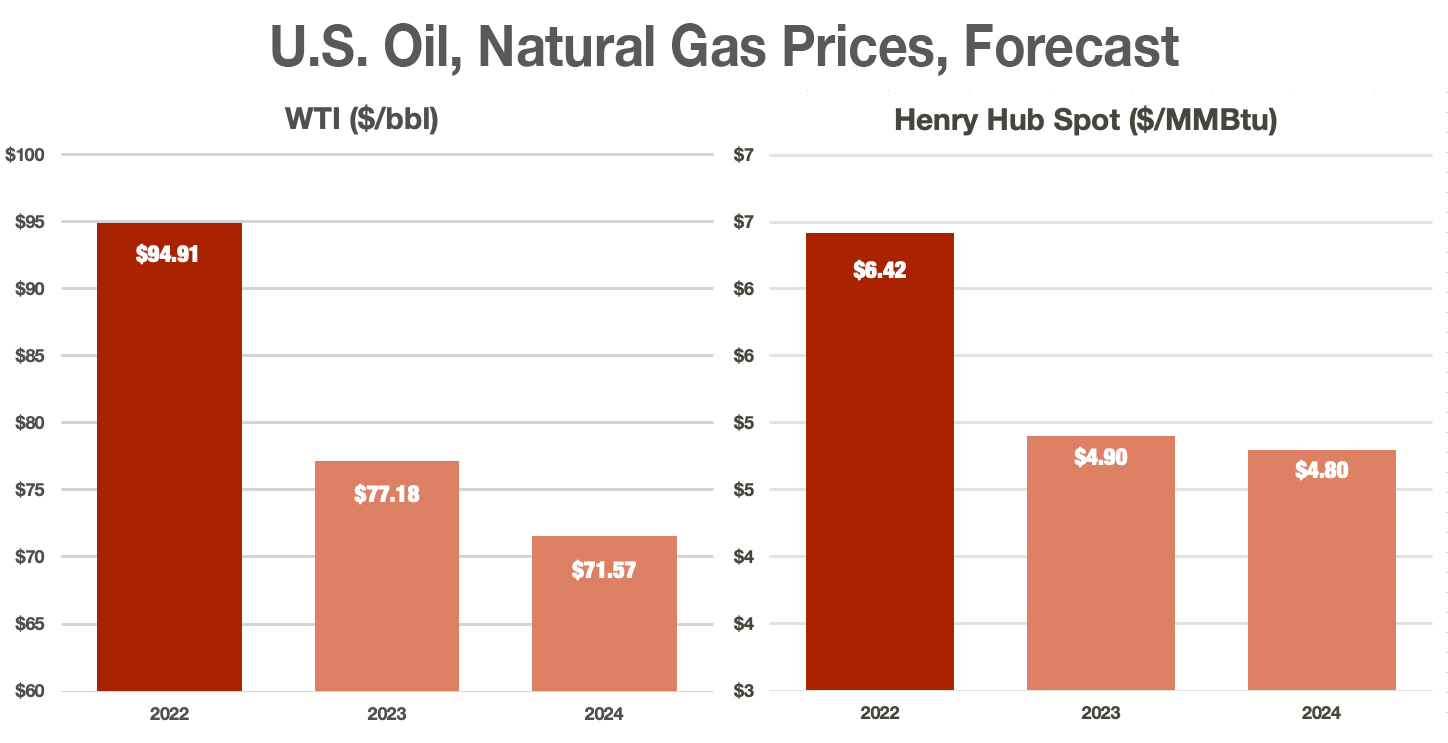
Weakened U.S. and global economies and higher production will lead to price cuts in 2023 of 10.6% for WTI and 9.8% for Henry Hub natural gas. (Source: Shutterstock)
The U.S. Energy Information Administration (EIA) slashed its 2023 estimate for the benchmark WTI average price by 10.6% to an average of $77.18/bbl in its forecast released Jan. 10. Henry Hub natural gas will average less than $5/MMBtu for 2023, a 9.8% reduction from EIA’s December forecast.
The WTI forecast for 2024 is $71.57/bbl, a further decline of 7.3%. The Henry Hub price is expected to slip to $4.80/MMBtu.
Industry analysts differed, with some less bearish than the EIA and saying the new year was off to an “ugly” start.
The forecast is based on expectations of anemic GDP growth of 0.5% in 2023, with growth only returning after contractions in the first and second quarters, the EIA said. Household consumption will drive a 1.9% increase in GDP in 2024, which will bolster energy consumption by 1%.
The EIA’s short-term forecast contrasted with bullish expectations from Enverus Intelligence Research. The consultancy forecast prices for global benchmark Brent crude oil of $83.10/bbl of $98/bbl in first-quarter 2023 to $108/bbl in the fourth quarter.
“We see more reasons to be bullish [on] oil prices than bearish, with global oil supply constraints set to keep balances tight despite a pronounced global economic downturn,” Bill Farren-Price, director of the Enverus subsidiary, announced in the forecast. He added that high prices amid a sputtering global economy could mean longer-term risks for oil because those prices could deepen and prolong an economic recession.
Midday on Jan. 10, WTI for near-month delivery was $75.61/bbl. Brent’s price was $80.57/bbl.
EIA expects global liquids production to grow by 1.1 MMbbl/d in 2023 and 1.7 MMbbl/d in 2024, a rate that will more than offset the loss of 1.5 MMbbl/d in production from Russia during that period.
“The largest source of non-OPEC production growth over the forecast period is the United States, which contributes 40% of growth in 2023 and 60% of growth in 2024,” EIA said. U.S. growth will be driven by increases in crude production in the Lower 48, mostly in the Permian Basin.
The production growth will keep prices in check even as consumption increases, the EIA said. That will result in global record liquids consumption of 102.2 MMbbl/d in 2024 if things pan out as expected.
“Our forecast for global consumption of petroleum depends on uncertain economic conditions—especially in China,” said EIA Administrator Joe DeCarolis. “How China’s economy changes following its reopening from pandemic lockdowns could have a significant impact on global consumption of petroleum products.”
Storage eased tight markets
Prices for both crude oil and natural gas slumped during the second half of 2022 as inflationary pressures forced consumers to cut back on driving, and releases from U.S. and international strategic petroleum reserve programs mitigated tightness in global markets, the EIA said.
Still, the Jan. 10 midday WTI price of $75.61/bbl was 45% above its close of $52.25/bbl two years ago, although a shade below the $78.23/bbl close of a year ago. Similarly, the Henry Hub price for natural gas was up 44% from two years ago and just 6% off the 2022 price.

From its peak of $123.70/bbl in March to the year-end close of $80.26/bbl, WTI fell 35%, and the tumble is likely to continue.
“This is as ugly a start to a new year for oil as we can remember,” Piper Sandler analysts wrote in their Jan. 5 research note. Their interpretation of the late-year rally—a 13% jump from Dec. 9 to the end of the year—is that “parts of the market want to look through the current weakness at the bullish balances for the year as a whole.”
On a global price basis, the spread between WTI and Brent widened to $5/bbl in 2022, compared to $3/bbl in 2021. EIA attributed the change to a strong demand in Europe to replace crude oil that was supplied by Russia prior to its invasion of Ukraine in February.
Other forecasts
The Henry Hub price of natural gas, which fell below $4/MMBtu in January, will surge above $5/MMBtu later in the month and remain there through February as temperatures decline and exports resume from Freeport LNG, boosting demand for gas.

The EIA predicts growth in natural gas production from 98.02 Bcf/d in 2022 to 100.34 Bcf/d in 2023 and 102.29 Bcf/d in 2024. Growth will come from both the Permian and Haynesville pipeline infrastructure as expansions are completed this year and next. Among those projects are the Gulf Coast Express expansion, Permian Highway expansion, Whistler Pipeline expansion, and in-service of the Matterhorn Express Pipeline in third-quarter 2024.
U.S. crude oil production, which averaged 11.86 MMbbl/d in 2022, is forecast to rise to 12.41 MMbbl/d in 2023 and 12.81 MMbbl/d in 2024. The EIA estimates OPEC’s oil production capacity at 31.08 MMbbl/d in 2022 and forecasts production of 31.82 MMbbl/d in 2023 and 32.42 MMbbl/d in 2024.

